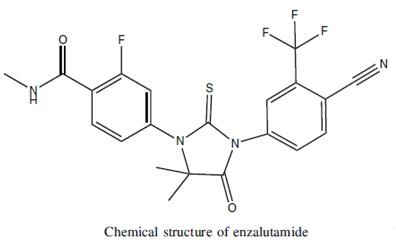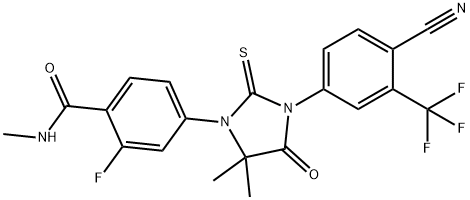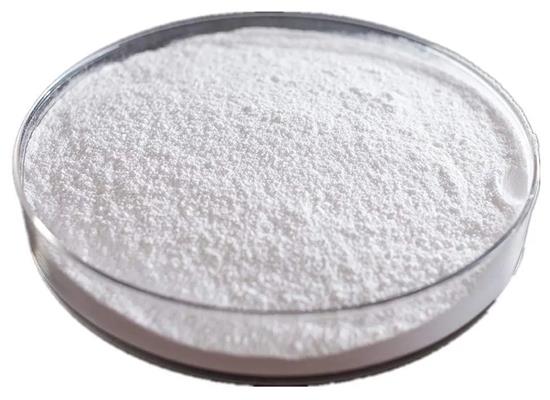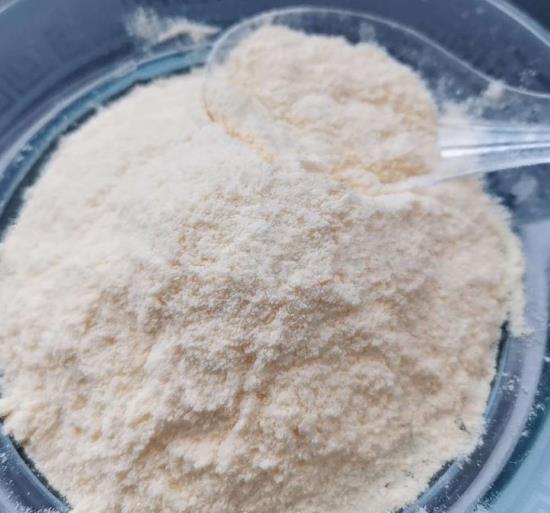MDV-3100 (Enzalutamide)- Pharmacodynamic Properties
MDV3100, known as Enzalutamide, is a second-generation androgen receptor (AR) signaling inhibitor. It is able to inhibit binding of androgens to the AR, AR nuclear translocation, and the association of the AR with DNA.
The AR is a 919-amino acid member of the steroid receptor transcription factor superfamily with different domains including an N-terminal regulation domain, a central DNA binding domain, and a C-terminal domain, which includes the ligand-binding domain incorporated within its protein structure. Enzalutamide has high affinity for the ligand-binding domain of the androgen receptor (fivefold to eightfold greater affinity than bicalutamide). As well as competitively inhibiting binding of androgens to androgen receptors, enzalutamide inhibits translocation of activated androgen receptors to the cell nucleus, inhibits the recruitment of androgen receptor cofactors and inhibits androgen receptor binding to androgen response elements within DNA. On positron emission tomography scans, uptake of the androgen receptor ligand 16b-18Ffluoro-5a-dihydrotestosterone (FDHT) was reduced by20–100 % in patients with CRPC who received enzalutamide 60–480 mg/day, indicating displaced FDHT binding[1-3].
In vitro, enzalutamide suppressed proliferation and induced apoptosis in human prostate cancer cell lines. The sensitivity of prostate cancer cells to T cell-mediated lysis via androgen receptor-dependent immunomodulation was enhanced by enzalutamide. Enzalutamide lacked androgen receptor agonist activity in CRPC cell models and induced tumour regression in CRPC xenograft models [1,2,4].
Several potential mechanisms of enzalutamide resistance in metastatic CRPC have been identified. One possible resistance mechanism is the presence of androgen receptor splice variants (i.e. truncated androgen receptor proteins that lack the ligand-binding domain, but remain constitutively active), in particular, androgen receptor splice variant 7 (AR-V7) . For example, among men with metastatic CRPC who received enzalutamide (n = 31), clinical outcomes were significantly (p\0.01) better in AR-V7-negative patients than in AR-V7-positive patients. Other possible resistance mechanisms include mutations (e.g. F876L) in the ligand-binding domain of the androgen receptor that confer enzalutamide with agonist activity, alternative steroid receptors (e.g. glucocorticoid receptors) driving expression of androgen-regulated genes, activation of the phosphatidylinositol 3-kinase signaling pathway, overexpression of NF-jB2/p52 and overexpression of programmed death ligand-1 [5].
In conclusion, enzalutamide is a convenient, effective and well tolerated treatment for chemotherapy-naïve men with metastatic CRPC who are asymptomatic or mildly symptomatic.

References
1.Tran C, Ouk S, Clegg NJ. Development of a second-generation antiandrogen for treatment of advanced prostate cancer. Science[J]. 2009, 324(5928):787–90.
2.Guerrero J, Alfaro IE, Gomez F. Enzalutamide, an androgen receptor signaling inhibitor, induces tumor regression in a mouse model of castration-resistant prostate cancer[J]. Prostate. 2013, 73(12):1291–305.
3.Scher HI, Beer TM, Higano CS. Antitumour activity of MDV3100 in castration-resistant prostate cancer: a phase 1–2 study[J]. Lancet. 2010, 375(9724):1437–46.
4.Ardiani A, Gameiro SR, Kwilas AR. Androgen deprivation therapy sensitizes prostate cancer cells to T-cell killing through androgen receptor dependent modulation of the apoptotic pathway[J]. Oncotarget. 2014, 5(19):9335–48.
5.Gillian M K. Enzalutamide: A Review of Its Use in Chemotherapy-Naïve Metastatic Castration-Resistant Prostate Cancer[J]. Drugs Aging, 2015, 32:243–249
You may like
Related articles And Qustion
See also
Lastest Price from Enzalutamide manufacturers

US $1.00-4.00/KG2025-05-15
- CAS:
- 915087-33-1
- Min. Order:
- 1KG
- Purity:
- 99%
- Supply Ability:
- 200000KG

US $0.00-0.00/KG2025-04-04
- CAS:
- 915087-33-1
- Min. Order:
- 1KG
- Purity:
- 98%
- Supply Ability:
- 1Ton





